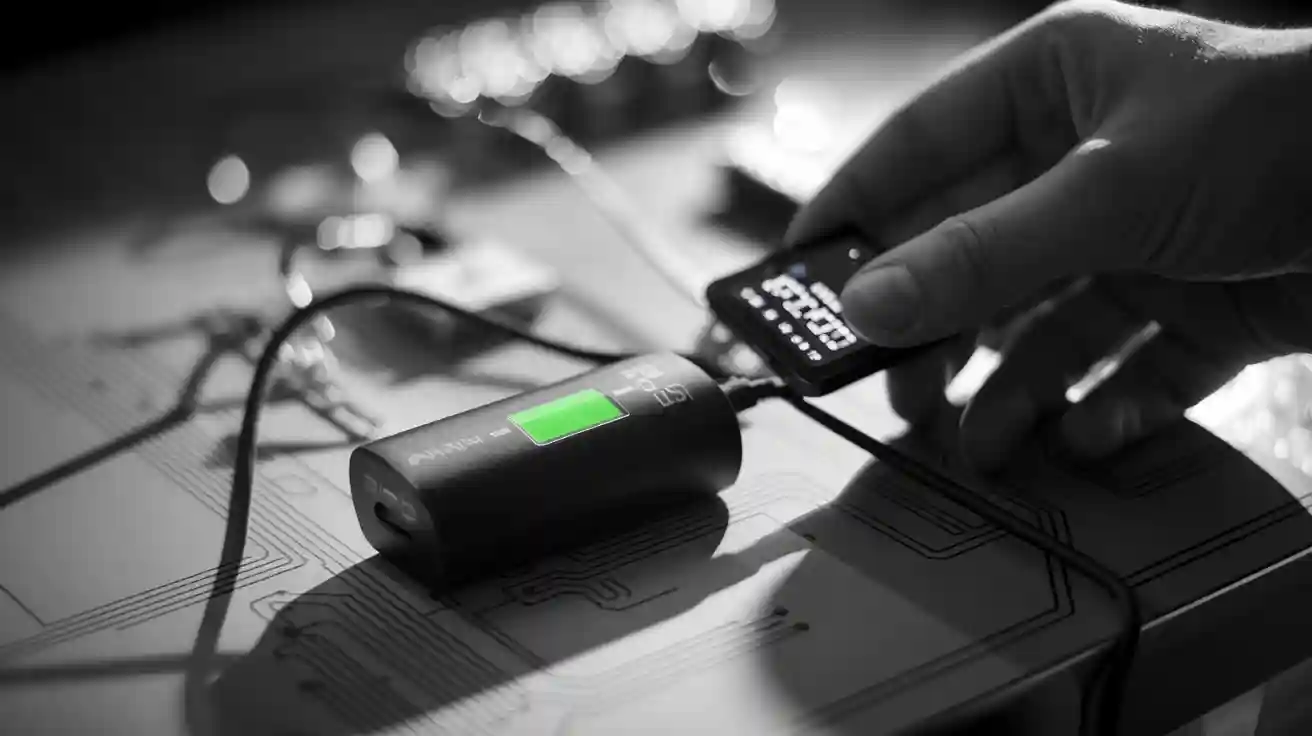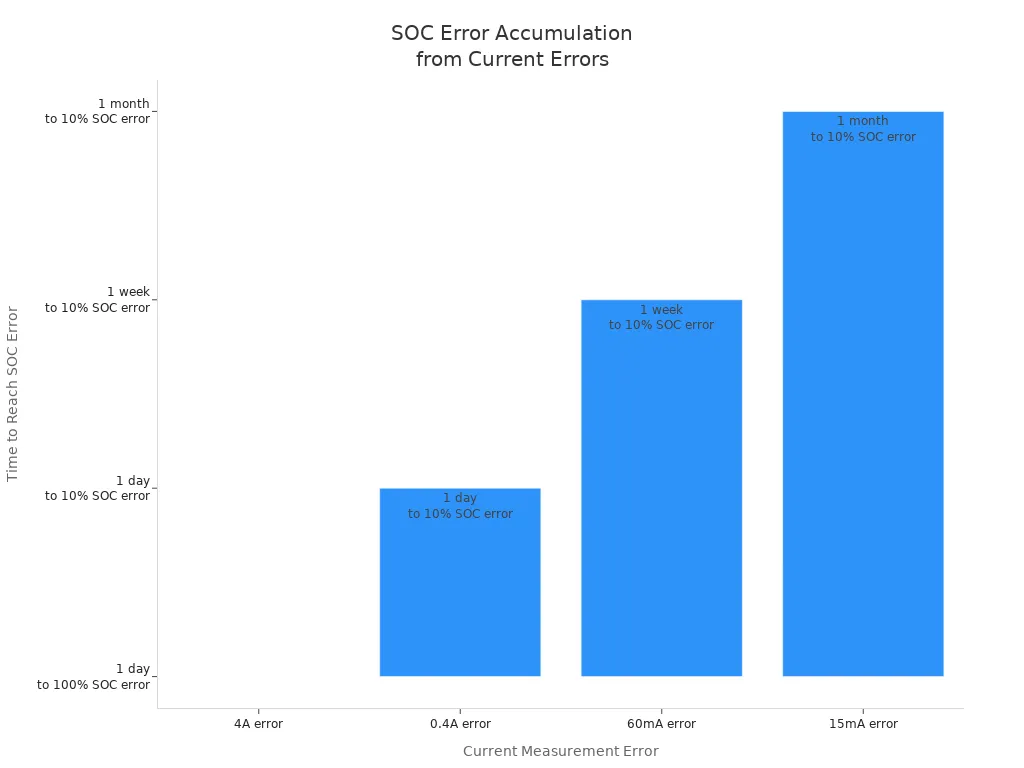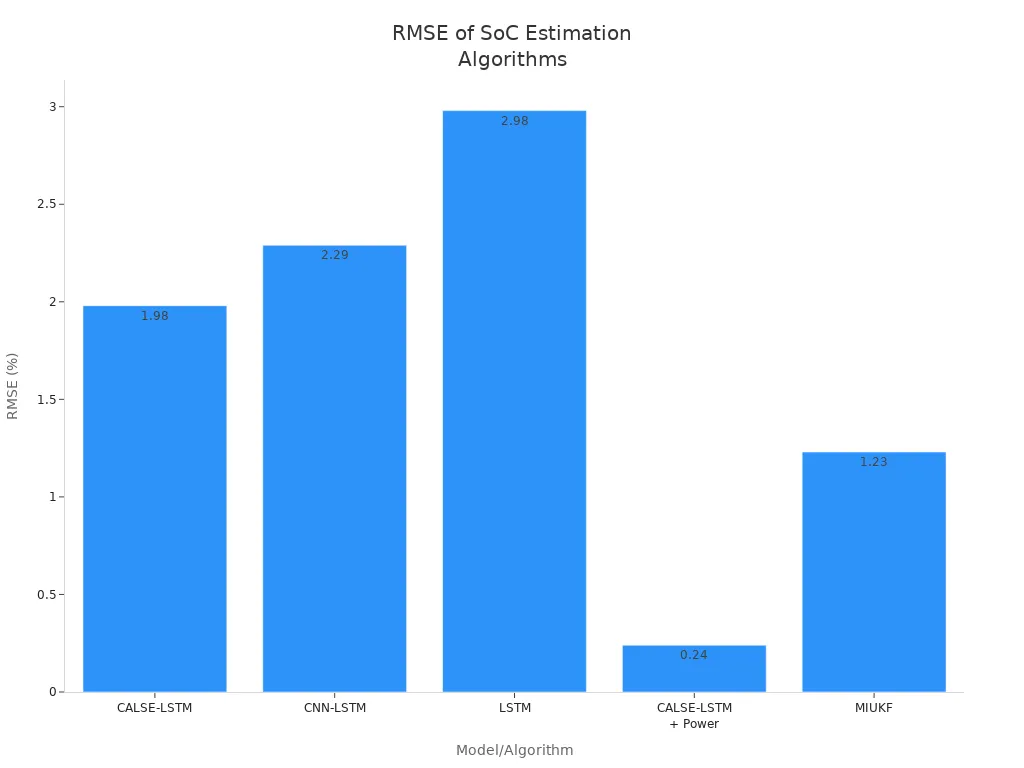
You can interpret the state of charge in LiPo batteries best by using reliable methods like amp hour meters and coulomb counting. Many people try voltage measurement, but it does not give accurate soc readings for lithium battery packs. Lithium batteries need more advanced approaches because their voltage does not change much with state of charge. If you want to keep your lithium batteries safe and get the best battery performance, you must track soc closely. Inaccurate soc can lead to overcharging or over-discharging, which harms lithium batteries and can cause dangerous situations. Modern devices use a mix of soc methods to protect lithium batteries and help you get the most out of your battery.
State of Charge Methods
When you want to know how much energy your lithium batteries have left, you need to choose the right method for measuring state-of-charge (SoC). Each method has its own strengths and weaknesses. Let’s look at the main ways you can check SoC in LiPo batteries.
Voltage Measurement
Les voltage method is the simplest way to estimate SoC. You measure the battery’s voltage and compare it to known discharge voltage curves. Many people use voltage checkers, multimeters, or built-in monitoring systems for this.
- LiPo battery voltage does change with SoC, but the change is not always clear.
- Les voltage stays almost flat during most of the discharge profile. It only drops quickly near the end, at the “knee” point.
- Load conditions and internal resistance affect the voltage. If you measure under different loads, the reading may not match the actual state of charge.
- Temperature and battery aging also change the voltage reading.
Conseil : Voltage thresholds help you avoid over-discharging and protect battery health.
Here’s a table showing how accurate the voltage method can be:
| Accuracy Range | Description | Facteurs d'influence |
|---|---|---|
| 20-25% (worst-case) | Simple voltage-based SoC estimation | Load current, temperature, battery type |
| Improved with compensation | Using current and temperature compensation | Compensation algorithms |
| ~1.5% (best with EKF) | Advanced voltage-based algorithms (EKF) | Model quality, algorithm complexity |
You can see that the voltage method works best when the battery is at rest and the temperature is stable. In real life, you often need faster and more accurate SoC readings, especially for lithium batteries with flat discharge curves.
Coulomb Counting
Coulomb counting is a popular way to track SoC in lithium batteries. You measure the current going in and out of the battery and add it up over time. This method gives you a real-time estimate of how much charge is left.
- Coulomb counting works well for lithium batteries because it directly tracks charge movement.
- You need a good starting point for SoC. If you start with the wrong value, errors will build up.
- Sensor errors, temperature changes, and battery aging can cause drift in the SoC reading.
- Regular calibration and battery capacity determination help keep the readings accurate.
Here’s a table showing common sources of error in coulomb counting:
| Source of Error | Description | Impact on SoC Estimation |
|---|---|---|
| Current sensor offset errors | Small sensor errors add up over time | Large drift if not calibrated |
| Thermal drifts in sensors | Sensor readings change with temperature | Can cause significant SoC errors |
| Battery leakage currents | Small currents that are hard to measure | Causes SoC drift, worse with aging |
| Initial SoC calibration | Need for accurate starting value | Errors here grow over time |
| Capacity variation | Battery capacity changes with temperature and discharge rate | Up to 15% error in battery capacity determination |

Coulomb counting is more accurate than the voltage method for real-time SoC tracking. With regular calibration and state of health checks, you can keep errors as low as 1%. However, without calibration, errors can grow over days or weeks.
Advanced SoC Algorithms
Advanced algorithms use models and machine learning to improve SoC accuracy. These methods combine data from voltage, current, temperature, and even battery aging to give you a better estimate.
Some common advanced methods include:
- Kalman filters (KF, EKF, UKF)
- Machine learning models like Support Vector Machines (SVM), Random Forest, and deep learning networks (CNN, LSTM)
- Electrochemical impedance spectroscopy
Here’s a table comparing some advanced algorithms:
| Modèle | RMSE (%) | Notes |
|---|---|---|
| CALSE-LSTM | 1.98 | Combines CNN, LSTM, and attention mechanisms; best accuracy among tested models |
| CNN-LSTM | 2.29 | Deep learning model without attention mechanisms |
| LSTM | 2.98 | Simpler model, shortest training time |
| EKF | 1.5 | Model-based, good for real-time use |
| SVM | 0.0319 | High accuracy, but needs more computing power |
| Random Forest | 0.0229 | Best accuracy, robust to noise, needs lots of data and computing resources |

Advanced algorithms can reach SoC errors below 2%, much better than simple voltage or coulomb counting methods. They can handle changes in temperature, battery aging, and noisy data. However, they need more computing power and detailed battery models. In real-world battery management systems, you may see a mix of lightweight models and advanced algorithms to balance accuracy and speed.
Remarque : New technologies like AI-driven battery management systems and electrochemical impedance spectroscopy are making SoC monitoring even more accurate. These systems help with optimization, battery capacity determination, and predicting battery health over time.
When you choose a method for measuring state-of-charge, think about your needs. If you need simple and quick checks, the voltage method may work. For better real-time tracking, coulomb counting is a good choice. If you want the best accuracy and can handle more complexity, advanced algorithms offer the most reliable SoC readings for lithium batteries.
SoC Accuracy Factors
Température
Temperature changes can make SoC readings in lithium batteries less accurate. When the temperature shifts, the battery’s internal resistance, polarization resistance, and open circuit voltage all change. If you ignore these effects, your SoC monitoring will show bigger errors, especially outside normal temperature ranges. For example, at very cold or hot temperatures, the battery’s behavior changes a lot. Advanced SoC management uses models that adjust for temperature. These models, like adaptive dual extended Kalman filters, update themselves as the temperature changes. They help keep SoC estimation accurate, even from -10°C to 50°C.
Conseil : To improve SoC accuracy, use temperature compensation techniques. Add bias compensation to your estimation algorithms, include temperature in your open-circuit voltage model, and use models that simulate battery polarization and diffusion. These steps can reduce SoC errors by up to 78%. Always keep lithium batteries within their recommended temperature range for the best battery performance and reliable SoC monitoring.
Battery Aging
As lithium batteries age, their capacity drops and internal resistance rises. This aging comes from both storage and repeated charging or discharging. These changes make SoC estimation harder because the battery’s behavior shifts over time. State of health becomes a key factor in SoC management. When the battery ages, the amount of charge it can hold drops, and the time it takes to charge fully changes. If you do not adjust your SoC monitoring for aging, your readings will become less reliable. Advanced estimation algorithms, like adaptive Kalman filters, can track these changes. They update the battery model as the state of health changes, keeping SoC readings accurate.
- To manage aging, run regular reference performance tests. These tests check capacity and internal resistance at different SoC levels and temperatures. Use the results to update your battery management system and improve SoC monitoring.
Calibration and BMS
Regular calibration keeps your SoC readings on track. If you skip calibration, your SoC monitoring can drift, leading to unexpected shutdowns or overcharging. You should fully charge your battery, let it rest, then fully discharge it, and repeat this process every few months. This resets the internal reference points in your battery management system.
A good battery management system plays a big role in SoC management. It balances cell voltages, protects against overcharging, and keeps SoC accuracy within ±5 to 8%. The BMS also uses advanced algorithms and impedance spectroscopy to track state of health and improve SoC monitoring. Make sure your BMS matches your battery’s cell count and current needs.
| BMS Feature | Benefit for SoC Monitoring |
|---|---|
| Cell balancing | Keeps all cells healthy and SoC accurate |
| Protection parameters | Prevents damage that skews SoC readings |
| Communication protocols | Shares real-time SoC data |
| Operating temperature | Maintains sensor accuracy |
Remarque : Combine regular calibration, a reliable BMS, and advanced SoC management with impedance spectroscopy for the most accurate SoC readings in lithium batteries.
Suivi et maintenance
Calibration Steps
You need to calibrate your LiPo batteries regularly to keep soc monitoring accurate. Calibration helps your battery management system reset its tracking and gives you more reliable soc readings. Here are the recommended steps:
- Discharge your battery until it reaches a low soc, but do not go below the safe limit to avoid damage.
- Let the battery rest for 4 to 6 hours with all devices turned off. This allows the battery to stabilize.
- Charge the battery slowly up to 80% or 100%. Avoid using ultra-fast charging methods.
- After charging, let the battery rest again for 2 to 4 hours with no load.
You should perform this calibration once every three months or after about 40 charge cycles. If your device does automatic deep discharges, you may not need to calibrate as often. Regular calibration improves soc accuracy and helps with range prediction.
Interpreting SoC Readings
To get accurate soc readings, you must understand what the numbers mean and avoid common mistakes. Many people look only at voltage under load, but this can mislead you. Always check the resting voltage and make sure your cells are balanced. If you let any cell drop below 3.5V under load, you risk permanent damage. Try to land or stop using your device when cells reach 3.6–3.7V under load, which means about 20–25% soc remains.
You should also monitor these indicators for better soc monitoring:
- Voltage and current during charging and discharging
- Temperature of the battery
- Internal resistance and impedance
- Charging times and voltage change rates
Combining these indicators gives you a clearer picture of your battery’s state of health and helps with soc management.
Conseil : Utiliser un chargeur équilibré and avoid charging batteries in parallel unless they have the same soc. This prevents uneven charging and keeps soc monitoring reliable.
Maintenance Tips
Good maintenance keeps your soc monitoring accurate and extends battery life. Here are some proven tips:
- Charge your batteries slowly and avoid fast charging to reduce heat and stress.
- Do not leave batteries charging overnight. Use a charger that matches your battery’s specs.
- Store batteries in a cool, dry place. Avoid high temperatures and direct sunlight.
- Garder daily charge levels between 20% and 80%. Only charge to 100% when needed.
- Avoid deep discharges below 25% soc to prevent damage.
- Nettoyer les bornes de la batterie regularly and check for corrosion.
- Perform calibration cycles every few months to maintain accurate readings.
- Monitor battery health indicators and replace old batteries when needed.
Improper maintenance can cause soc monitoring errors and even safety risks. By following these steps, you support both soc management and state of health, ensuring your batteries stay safe and reliable.
You can achieve the most accurate soc readings by using coulomb counting with regular calibration. Advanced battery management systems combine current, voltage, and temperature data for even better soc accuracy. Remember, temperature and battery aging affect soc, so always monitor these factors.
Store your LiPo batteries at 50-60% soc when not in use and avoid deep discharge. These habits help prevent damage and extend battery life.
FAQ
How often should you calibrate your LiPo battery for accurate SoC readings?
You should calibrate your LiPo battery every three months or after about 40 charge cycles. Regular calibration helps your battery management system stay accurate and keeps your battery healthy.
Can you rely only on voltage to check LiPo battery SoC?
Voltage alone does not give you a reliable SoC reading for LiPo batteries. The voltage stays flat for most of the discharge. You should use coulomb counting or a battery management system for better accuracy.
What happens if you over-discharge a LiPo battery?
Over-discharging can damage your LiPo battery. You may lose capacity, shorten battery life, or even cause safety risks. Always stop using your battery when cells reach about 3.5V under load.
Why does temperature affect SoC accuracy?
Temperature changes the battery’s internal resistance and voltage. If you ignore temperature, your SoC readings can become inaccurate. Use temperature compensation in your monitoring system for better results.

